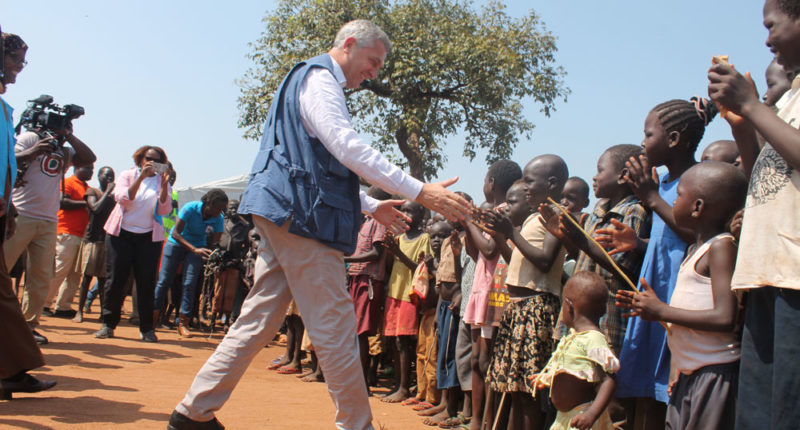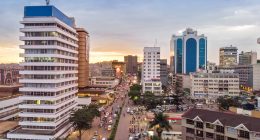In August 2016, I had an opportunity to visit Nyamanzi refugees’ transit centre and Pagrinya refugee settlements in Adjumani District. At the time, the United Nations High Commissioner for Refugees, Filippo Grandi, was in Uganda assessing the plight of refugees and making a clarion call for the international community to fulfill their pledges when the refugee crisis hit Africa.
Nyamanzi Refugees transit centre was overcrowded. It sits on two hectares and is supposed to shelter less than 2,000 people butwas hosting 7,000 refugees when I visited. At Nyamanzi, the UNHCR entourage was welcomed by cheerful refugees with dancing, dressed in patched clothes and walking bare foot. Children lined up in hundreds singing “welcome our dear visitors”. The centre was visibly a refugees’ domicile.
Pagrinya Refugee Settlement on the other hand seemed like a typical Ugandan village. Refugees had been given land and had started gardening, while about 10 or 20 had opened shops and bars. The area could only be distinguished from others in Adjumani villages by the makeshift homes that were laid out in the settlement.
The Pagrinya settlement is a small-scale showcase of Uganda’s progressive approach to refugees’ management. Embodied in the 2006 Refugees Act and 2010 Refugees Regulations, Uganda’s refugee policy has many impressive features, among them opening Uganda’s door to all asylum seekers irrespective of their nationality or ethnic affiliation, granting refugees relative freedom of movement and the right to seek employment, and giving a piece of land to each refugee family exclusively for agricultural use.
A unique policy
In Uganda, the Word Bank says, refugees located in rural settlements, whether on community-owned or gazetted land, are able to access basic services, receive physical protection, and cultivate land provided to them for self-sustenance.
“Refugees with some income or ability to fend for themselves are self-settled in urban centers. A commendable level of peaceful co-existence is evident between refugees and host communities in all the settlements. Intermarriages are reported in many settlements, contributing to improved relationships,” states a 2016 World Bank working paper which gave an assessment of the evolving refugee policy and practices in Uganda.
On the employment front, the bank says, more than 78 percent of refugees in rural settlements are engaged in agricultural activities compared with 5 percent in urban areas. “The refugee labour force participation rate is an average 38 percent compared with Uganda’s 74 percent. A variety of non-farm activities supplement agriculture, including trade, which is facilitated by the freedom of movement and the right to work per the Ugandan Refugees Act,” World Bank reported.
The assessment further revealed that business enterprises such as bars, hair dressing, milling, transportation, money transfers, and retail are run by refugees. And in terms of employability and economic integration of refugees, almost 43 percent are actively engaged in the labour market of their host communities, 12 percent in the formal sector and 31 percent self-employed.
Life of a Ugandan refugee
John Mayom, 34, has been staying in Uganda since 2014 as a refugee and is currently pursuing a Master’s degree in Development Economics at Makerere University. He says Uganda is generous to refugees. “I have benefited a lot from Uganda. Even here at Makerere, I am not treated like a refugee or a foreigner but like a Uganda because I pay the same tuition as the Ugandans pay,” Mayom says. “South Sudan refugees living in Uganda are far better and secure than those who decided to stay behind in South Sudan’s refugee camps.” Mayom says he will think about returning home after completing his post graduate degree in June 2018 “depending on security situation.”
Somali refugee, Ali Abukar Ahmed is a father of two and businessman has been in Uganda since 2009. He operates a mini supermarket in upper Kisenyi, an area that has turned into a sort of Somali town. Almost 100 percent of the businesses in the area are Somali-owned, as well as the language, dress code, and culture.
“I think there is no other country that would allow us (refugees) to move freely and do business like Uganda,” says Ahmed. “It took less than a week to secure a permit to start this shop in 2010. If I hadn’t, I would have eaten through all the money I came with and where would I be?”
The background
According to the Minister for Relief, Disaster preparedness and Refugees, Hilary Onek, Uganda’s refugee policy dates back to the Second World War, when Polish refugees who arrived between 1942 and 1944 were settled in Masindi and Mukono districts. The East African publication in an article, How East Africa became home for Polish exilesexplains that refugee camps in Uganda were built at Koja, on the shores of Lake Victoria and Nyabyeya, Budongo Forest Reserve in Masindi that housed about 3,635 Poles. The second camp was established at Koja in Mukono District and at its peak, Koja accommodated about 3,000 Polish refugees.
“Since then, we have been receiving many refugees,” says Onek. “During the 1950s and 1960s, many Rwandans and Sudan refugees entered Uganda.”
Onek says during 1950s and 1960s, government British colonialists thought the best way of sustaining refugees was giving them land. “Government land doesn’t belong to refugees, they are given to settle on it and once their countries become peaceful, government reclaims its land and do with it as it pleases. That policy has continued to date,” explains the Minister.
The statistics
Uganda hosts over 1.2m refugees largely from South Sudan (0ver 75 percent), a country devastated by civil war, although efugees have also been coming from Democratic Republic of Congo, Somalia, Rwanda, Eritrea and Burundi. As prospects of a peaceful South Sudan continue to bleak, its population continues flee their country. According to the United Nation High Commission for Refugees, a total of 12,221 South Sudanese refugees arrived in Uganda between 8 and14 May, 2017, making a daily cross-border average of 1,746 refugees.
The agency reported that 916, 784 South Sudan refugees were in Uganda by May 15, 2017, compared to 366,000 South Sudanese refugees hosted in Ethiopia, 108,000 South Sudan refugees in Kenya and 74,000 refugees in Democratic Republic of Congo.
UNHCR and Uganda government have revised South Sudan refugees projected arrival figure to 400,000 for 2017 and year projection 1,025,000 refugees, Ethiopia projects to receive 405,000 refugees by end of 2017, Kenya 120,000 and Democratic Republic of Congo 105,000 South Sudan refugees.
The situation elsewhere
Uganda’s refugee policy has been touted globally as “progressive” because of its capacity building aspect. The policy is incomparable to its neighbours. In 2010, for instance, Ethiopia introduced a new approach exclusively for Eritrean refugees by allowing them to live outside camps. Under ‘out-of-camp’ scheme, Eritreans who can sustain themselves financially or have relatives or friends who commit to supporting them no longer can leave the camps. But refugees from other countries aren’t allowed to get out of camps, although the country is promising a fresh refugees policy.
UNCHR is assisting the Ethiopian government to develop structures meant to create a legal environment conducive to the implementation of the set of pledges the Ethiopian government made at the Leaders’ Summit in New York in September 2016.
In Kenya, terrorist attacks have prompted government to introduce changes to its refugee policy. One notable change was the introduction of an encampment policy requiring all asylum seekers and refugees in urban areas to relocate to designated camps.
Is Uganda’s policy sustainable?
Humanitarian agencies caring for refugees have been overstretched due to limited financial resources available. Jean-Luc Anglade, Médecins Sans Frontières (MSF) head of mission in Uganda explains the situation; “Despite the large-scale humanitarian mobilization, the emergency response is still far from being sufficient, and many people have been left with insufficient water, food, and shelter.”
He says many newly arrived refugees have no choice but to sleep under trees, and delays in food distributions and a lack of potable water have even prompted some refugees to return to South Sudan.
The scale of the refugee influx has pushed Uganda’s progressive refugee policies. “We are now currently trying to review this method of managing refugees whether viable or not and what we know land is not elastic but our population is increasing and demand for land is going up,” Onek says. He says government will review policy to see if it’s going to be sustainable or if they are going to proceed with it, for what category and how many refugees can be sustained.
“As far as I am concerned I know that the current method of settling refugees in land is not sustainable but we are reviewing it and we shall find a solution,” he says.
Onek admits to government having run out of land in northern Uganda but says generous communities are offering their land to refugees, on condition that when they return home owners get back their land. About 250 square miles of land are being occupied by refugees in West Nile.
Government of Uganda and the United Nations in June hosted a Solidarity Summit on Refugees in Kampala to raise global awareness about the plight of refugees and raise funds to support them and their host communities. At the time of writing this article (May 2017), Mr Onek said they expected donors to commit 2bn US dollars (sh 7.2trn) per year for refugees support.
Maintaining refugees is costly to the Ugandan government. “The heavy trucks carrying food to the camps damage our roads, we spend on them medically and have to educate their children,” explains Onek. Government has developed a four year programme that will cost USD 8bn, about Shs 28.8 trillion. Part of the USD 2 billion Uganda is seeking per year will be used to restore services such as schools, hospitals and roads. Hon. Onek says 60% of the money will be used for infrastructure development while 40% will be used to provide basic necessities for refugees.








